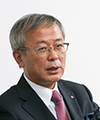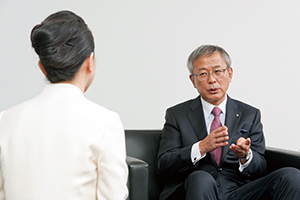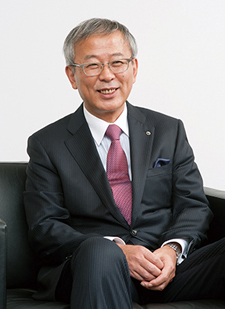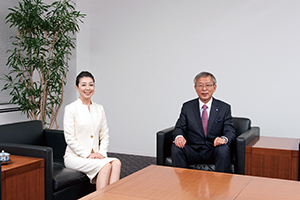 |
|||
|
|
|||
|
View from the Top Vol. 13, No. 1, pp. 1–4, Jan. 2015. https://doi.org/10.53829/ntr201501tp1  Strengthening the Individual to Reinforce the Entire Group —Towards the Next Stage 2.0OverviewInformation and communication technology (ICT) has become an indispensable part of our lives supporting finance, education, medical care, and public administration. What kind of viewpoint or behavioral pattern must experts and specialists have in order to develop innovative technologies for achieving a safe and secure society? We sat down with Representative Director and Senior Executive Vice President Hiromichi Shinohara to find out how NTT deals with this question as a leading company. Keywords: R&D, efficiency, competiveness Making R&D more competitive and efficient—Mr. Shinohara, it’s been about half a year since you took up your post as Senior Executive Vice President. Please tell us about the conditions that surround technology development today and its future direction. Well, I see no difference in direction between my position as Head of R&D Strategy Department and as Senior Executive Vice President, but I do feel that my view of research and development (R&D) from a management perspective has intensified. Of course, the importance I place on R&D to grow the NTT Group has not changed, but I must now consider how to make R&D more efficient and competitive across the entire NTT Group. At present, each of the Group companies is pursuing R&D based on its own policies, which means that work can sometimes be duplicated. To prevent this from happening, I bring together the heads of technology development at each Group company so that they can talk about how to pursue joint development and how best to eliminate overlap in order to optimize work in hot-topic areas such as big data, software-defined networking, and network functions virtualization. It may be thought that this approach is taken on behalf of the NTT laboratories by NTT as the holding company, but it’s essential to enhance the competitiveness of the entire NTT Group. As one who is promoting more efficient and competitive R&D, I consider that one of my new duties is to make it absolutely clear that this approach that I advocate always has the profits of the entire NTT Group in mind. Changing gears! The ‘whole’ cannot be reinforced without strengthening the individual.—It seems that attempting to make R&D more efficient while trying to make it more competitive at the same time is somewhat of a contradiction. How should researchers take on this challenge? I consider both to be important and both to be a matter of priority! For example, it goes without saying that R&D is absolutely necessary for an enterprise like the NTT Group that seeks to grow its business by developing and commercializing new technologies and services. On the other hand, making R&D more efficient is a necessity from the viewpoint of corporate management. In addition, these two goals of raising the efficiency and competiveness of R&D are not contradictory; both can be achieved together. The NTT Group boasts about 2500 researchers within the holding company alone as well as many and diverse research fields appropriate to such a large number of researchers. Efficiency and innovation are necessary in all research fields, but the specific means of achieving them vary depending on the research theme and development phase. For example, even in the case of “open innovation” that we have recently been emphasizing, researchers need to be aware of what approach should be taken in each research field within the entire NTT Group. This is especially true when researchers are considering their respective roles in open innovation and collaboration. It is not simply a matter of giving work that one cannot do to others; one must be knowledgeable of one’s own strengths and those of other team members and combine those strengths. This assessment can be different depending on whether or not the R&D in question is pursued with a strong sense of purpose. It means the difference between having a desire to develop technology that people find attractive or having a desire to provide society with something really useful. If the latter, the most optimal technology would naturally be selected, as opposed to holding on tenaciously to one’s own technology. I would also like to have our researchers “change gears” according to the present stage of their work. At the research stage, I would like the focus to be on achieving results that individuals are recognized for, such as published papers, but in the commercialization stage, I would like the focus to be on social contributions and product and service penetration. This way of thinking should prevent individuals from taking matters concerning open innovation at their own pace and minimize lost opportunities to make proposals to the market. It should also help transform the cooperative system within the NTT Group.
—I see: testing the waters and changing gears in research work based on many aspects such as the individual’s attitude and market conditions are important. The direction to take can be clarified in this way. To begin with, I would ask a researcher to reassess the project that he or she is working on. In the case of basic research, one cannot cut corners and do shoddy work. At the same time, commercializing the results of research for practical use is important. I would like the researcher to consider the state of progress of the research and current market trends and give serious thought as to how that project is currently positioned in the steps involved in moving from basic research to commercialization. To the researcher, I would say: “Try changing your point of view by putting yourself in the mind of a person one or two levels higher than you.” R&D is an aggregate of “individuals” having different values. If all employees exhibited the same behavioral pattern, we could not hope for any improvement in values. I believe that it’s important that each researcher be aware of the type of behavioral pattern that he or she should adopt. It’s not a question of simply receiving orders from above and doing what one is told. It is more important to ask oneself what role one should play as a researcher and get moving by looking upon that role as “work.” By the way, it’s not my intention here to impose a certain way of doing things on anyone. I would like all of our researchers as specialists to find on their own the best techniques to achieve their R&D goals. That is, I would like them to find the best way to reach the summit of the mountain they are climbing. What’s important here is that the mountain that each of us must climb is something common to all of us. For this reason, I ask researchers to not get caught up in the words uttered by their superiors and colleagues but to continuously refine their ability to grasp the real meaning or intention behind those words. The whole cannot be reinforced without strengthening the individual! Towards the Next Stage 2.0: Updating NTT’s Medium-Term Management Strategy—What, then, is the mountain to climb in 2015? NTT announced an update to its Medium-Term Management Strategy as part of its first-half financial results for the fiscal year ending March 31, 2015 released last November. This update, called “Towards the Next Stage 2.0,” states that management will place more importance this year on increasing profits. This includes cost efficiency made possible by our innovative technologies. For corporate management, cost efficiency is extremely important along with increased profits. However, employees say that they don’t feel a boost in morale when hearing that their work is contributing to “cost efficiency.” Perhaps this is because of the feelings evoked upon interpreting the words “increase” and “efficiency.” At the risk of repeating myself, though, there is value in cost efficiency. Let me tell you about our undertakings this year in the form of three main projects.
1. Strengthen the competitiveness (enhance the profitability) of network services Strengthening the competitiveness of our network services can only be achieved through technology development. In just these last few years, we have been introducing integrated-layer transport equipment (100G Policy Traffic Switch) to simplify the network originally configured with multistage connections and a Packet Transport Multiplexer link system to achieve low-cost transmission by integrating the fixed telephone network and the Internet on the packet network. These measures have been achieving cost efficiency and contributing greatly to meeting management objectives. So this year too, I ask our researchers to work with conviction in strengthening the competitiveness of our network services. As for enhancing the profitability of our network services, I will promote R&D on finding ways of using the network to increase revenues in addition to efforts at streamlining network operations and making them cost efficient. However, I would like to see the NTT Group create new value together with our partners in a behind-the-scenes role, not as a main player. Of importance here is that the results of collaboration in R&D have the power of making 1 + 1 equal not 2 but rather, 3 or 4! This is what I expect of R&D. I would like to move forward by taking the viewpoint of our partner and thinking always how best to use the results of our research to increase our partner’s value. 2. Strengthen the cyber security field This year, we will also work to strengthen the field of cyber security. As you know, cyber attacks are increasing dramatically year-by-year and evolving rapidly. In today’s society, all industrial fields including power, transport, and distribution are interconnected via the network. It is therefore imperative that we as an ICT enterprise increase our cyber security abilities, but at the same time, society on the whole must deploy and strengthen cyber security systems. With this in mind, we will first undertake the development of cyber security professionals within the NTT Group. In a five-year plan running to 2020, the goal is to train about 10,000 employees within Japan in development, consultation, and other cyber security-related areas. Additionally, in the new fiscal year, we will contribute to cyber security training for Japan on the whole. For example, we will provide a course titled “Cyber-attack and Cyber-defense Technologies” at Waseda University. This course will be given by NTT engineers active in the field and will cover the ever-changing conditions in cyber security. In the future, we would like to expand such courses to many more universities in collaboration with other companies. We are also endeavoring to provide a course titled “Information Security for Complete Novices” as part of gacco, a joint project of NTT DOCOMO and NTT Knowledge Square providing MOOCs (massive open online courses). 3. Make social contributions through globally advanced technologies We will advance the preparation for the international sports event to be held in Japan in five years. Of course, we can anticipate all kinds of attacks from fame-seeking hackers as is typical of major events, so enhancing cyber security for this event is a must. For this reason, we will mount a full response to these threats by establishing a close link between operations and technology development. We also expect network traffic characteristics that we have not experienced before to occur in certain areas and during certain time periods as spectators congregate or move about during this event. The challenge here is to come up with novel means of dealing flexibly and economically with these traffic characteristics and raising reliability, including the use of Wi-Fi*. We have already begun testing with a focus on detecting the signs of such traffic characteristics. In addition, we aim to leverage advanced technologies to present information with a high sense of presence heretofore not experienced and to provide a user-friendly network environment. Our target audience here will not only be tourists from abroad but also those attending events in various regions of Japan. I believe that the provision of technologies and services that can inspire and surprise society can help foster the development of children—our future leaders—and provide a great opportunity for Japan to display its fundamental strengths to the world. —Mr. Shinohara, as we enter a new year, can you leave us with a message for all NTT employees? I would be happy to. First, to our young employees, please keep in mind that a wide variety of viewpoints can be used in assessing whether something is right or wrong, and what is right or wrong can even change with the times. So please try to state your case to the people around you based first on your own logic. Then, if opposing opinions are expressed, use that as an opportunity to reevaluate and refine your ideas instead of getting discouraged. What you should fear is losing out on an opportunity to grow. Next, to our medium- and long-term employees, the time you have left to experience your work is, in reality, becoming shorter compared to your younger days. So be aggressive in expressing your opinions before it’s too late. Both autonomy and heteronomy are important. Make an effort to create an environment in which you can listen to the opinions of those around you and revise your own opinions accordingly.
Interviewee profileCareer highlightsHiromichi Shinohara joined Nippon Telegraph and Telephone Public Corporation (now NTT) in April 1978. In June 2003, he became a Vice President of Access Network Service Systems Laboratories of the Information Sharing Laboratory Group. He became a Senior Vice President of the Information Sharing Laboratory Group in June 2007. In June 2009, he became a Member of the Board of NTT and Head of R&D Strategy Department. In June 2012, he became Executive Vice President and Head of R&D Strategy Department. In June 2014, he took up his present position. |
|||



